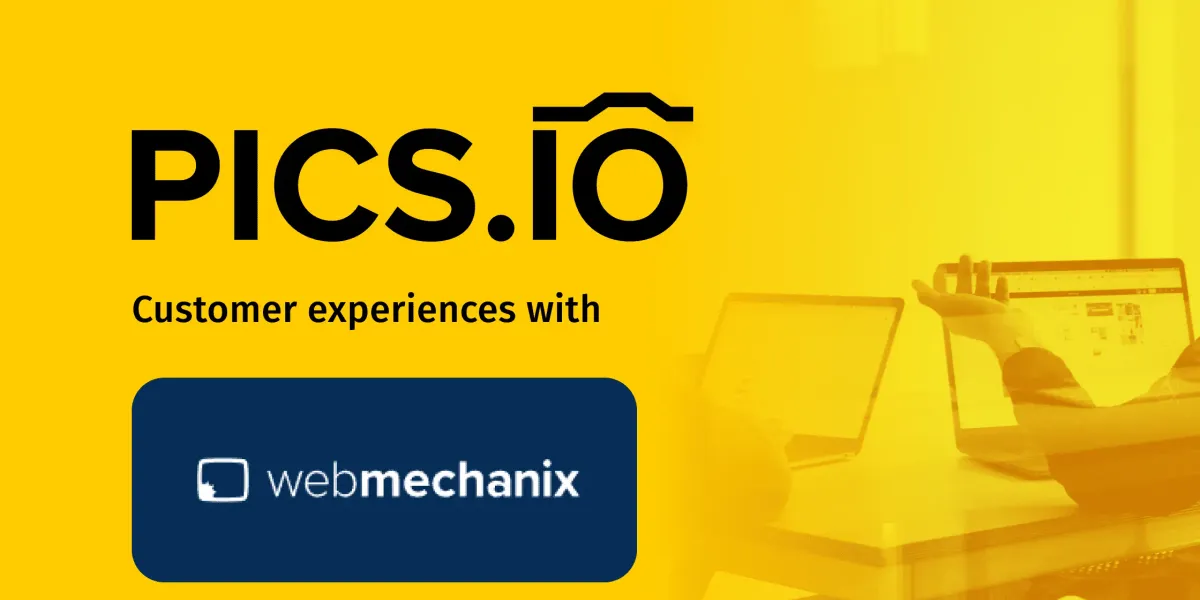In this article, you’ll learn:
Digital marketing requires lots of planning and high-level organization. You cannot run a successful marketing campaign without organizing work in advance and having all the materials you need at hand. Marketing asset management software or MAM, was created to help marketers with all these tasks.
In this article, we’re explaining what marketing asset management is, its benefits, and why use it. Read on!
What are Marketing Assets
Marketing assets are a broad range of materials and content to support marketing efforts and engage with target audiences. These assets can vary widely in format, including digital, written, audio, and even physical forms.
Some examples of digital assets are emails, which are tailored for direct communication with customers, and blog posts, which provide valuable content, insights, or entertainment to readers, as well as enhance SEO. Social media content and infographics also fall into this category.
More information on digital marketing assets in our article here.
Audio assets, such as podcasts, are increasingly popular. They can enhance brand recognition and provide content in a format convenient for on-the-go consumption.Physical marketing assets, though traditional, remain influential. These include brochures, business cards, and branded merchandise— and when paired with QR codes, they can seamlessly connect offline materials to online content for deeper engagement.
Marketing Assets Lifecycle
The lifecycle of marketing assets unfolds in several key stages, much like the life journey of a product. It begins with the Creation stage, where ideas are brainstormed, and assets like blog posts, images, and videos are produced. This is the drawing board phase, where creativity blooms.
Next comes the Management stage. Here, assets are categorized, stored, and organized in a way that makes them easily accessible.
Then, we move to the Distribution stage. This is where your assets reach audiences through various channels like social media, email, or your website.
The Exploitation stage is where you squeeze every bit of value from your assets. Here you repurpose existing assets across different platforms or update them to remain relevant.
Finally, the Evaluation stage closes the loop. Performance is analyzed to see what worked and what didn’t. This feedback informs future content creation and makes the next round of assets even more impactful.
A marketing asset management tool is what you need throughout all these stages to make the most out of your time and marketing efforts. Let's see how it works.
What is Marketing Asset Management
MAM is a smart digital library for all the stuff a company uses to show off and sell its products or services. Imagine you have loads of pictures, videos, brochures, and social media posts that you need to keep organized and easy to find. Marketing asset management software is the tool that helps you do just that.
MAM keeps all your marketing goodies in one place online. So, if you need to find a product photo or a specific ad you made a while ago, you can just search for it in the marketing asset management system. No more digging through folders on your computer or asking coworkers to send you files.
But it's not just about storage. MAM also makes sure that everyone in your team uses the right version of a logo or ad. This way, everything your company puts out looks consistent, professional, and on-brand. Plus, it lets team members share files easily without clogging up email inboxes or DMs.
Some dedicated MAM software solutions also embed CRM functionality. For example, HubSpot ports over each brand’s contact database. This lets you identify cross-selling or up-selling opportunities across your entire customer base and adjust campaign assets for maximum effect.
Who Uses Marketing Asset Management Software
MAM serves a wide range of professionals:
- Marketing teams use it to keep their campaigns organized and maintain consistent messaging across all marketing channels.
Here's an example of how the WebMechanix marketing team uses Pics.io digital asset management tool for their work.

- Salespeople store sales materials, such as the latest brochures or presentations in this software, so that they're always pitching with up-to-date materials.
- Designers and creatives store and retrieve their artwork (including Figma and Sketch files), collaborating without the chaos of endless file versions.
- Communication specialists can access press releases, corporate branding guidelines, and other documents.
Essentially, anyone involved in creating, managing, or distributing digital content finds marketing asset management software to be an invaluable tool that helps them stay organized, efficient, and aligned with their team's goals.
Benefits of Marketing Asset Management
Let’s talk about what advantages a MAM system brings to the table on the example of Pics.io:
Keep Everything Organized
A marketing asset management tool helps to store, organize, and manage all your marketing collateral - documents, videos, images, etc. All these marketing assets are properly tagged and easily accessible because MAM supports multiple file formats and even web pages.
If you're already using Google Drive or Amazon S3 storage, you can integrate Pics.io on top of them and take their functionality to the next level.
You can create your own folder structure and metadata that will work for your marketing team or agency. In such a way, you can name and tag all the materials related to different campaigns, projects, clients, etc. To make things even faster, Pics.io offers AI tagging.
Save Time
With everything in one place, you can find what you need fast. Metadata helps you sort through digital assets and retrieve the necessary ones in seconds. MAM system also has advanced search tools to make your search results even more precise and refined.
Share Files in a Few Clicks
Share your marketing materials with team members or partners via websites and receive files with inboxes. Both of these tools are branded portals shareable by a link. They have multiple settings, such as password protection, user permissions, etc.
Maintain Brand Consistency
Brand consistency is no joke in marketing and MAM can help with that too. The version control feature allows to keep all file versions and track the history of changes, while the visual difference tool makes comparing digital assets actually an enjoyable experience. You can also switch between versions at any time and set one of them as the current.
All the brand assets, including logos, color schemes, and fonts, are stored in one place, so any team member can access and retrieve them whenever it’s needed. Due to this, all marketing materials used, whether online or offline, adhere to brand guidelines.
Protect Your Work
MAM keeps your important marketing stuff safe from getting lost or accidentally deleted, like a digital safe. Moreover, marketing asset management software has different levels of access for both internal and external users. You can grant user rights depending on one’s job within a company. For example, copywriters can upload, edit, share, and download documents. However, they can only view images.
Work From Anywhere
With a marketing asset management system, you can access marketing materials from any computer or phone, so you can work even when you’re not in the office. This is especially useful when something urgent happens and you don’t have access to the computer.
Make Teamwork Better
Everyone can work together smoothly without stepping on each other's toes. User permissions, instant notifications, the ability to leave comments and tag teammates - all these and many other tools in a MAM improve collaboration within a team.
Marketing asset management tool is also beneficial for remote and international teams as they can still collaborate effectively and access the same marketing materials.
Track What Works
The analytics feature in marketing asset management shows you which marketing pieces are stars (were downloaded the most often) and which ones need a bit more rehearsal. In such a way, you can understand what content your target audience prefers.
Repurpose Content
Repurposing content means taking one idea and sharing it across many places—like writing a blog post, posting on social media, and making a YouTube video about the same thing. To be honest, it saves lots of time and effort for marketers and is quite efficient. Marketing asset management software is your closet organizer for all these activities. It helps you keep track of everything you create, so you can find and use it fast.
Moreover, you can even link the necessary assets and then find them quickly. For example, you can link a Word document with a blog post, another document with texts for social media posts, and a picture created by a designer for social media. So, all your marketing materials are better organized.
If you want to learn more about marketing asset management benefits, check our article here.
Marketing Asset Management Use Cases
Below, we're discussing the most common use cases for marketing asset management software:
Content Creation and Distribution
Marketers can create, store, and manage all marketing content, such as blog posts, videos, and social media posts. They can easily distribute this content across various channels directly from the MAM system.
Collaboration Across Teams
MAM facilitates collaboration among marketing teams, designers, and external partners by providing a central repository for all assets of different formats. This improves workflow efficiency and reduces the time spent on searching for and sharing assets.
Regulatory Compliance and Risk Management
By using a MAM system, companies can ensure that all their marketing materials are compliant with industry regulations and standards, minimizing legal risks.
What Marketing Tool to Choose
Efficient marketing requires using different software services to perform all the activities successfully. A marketer needs to be able to upload a blog post on a website, edit or compress featured images or ad designs, etc. With multiple tools available, it's not an easy task to make a choice. Let's have a look at the most popular options:
MAM vs DAM
Marketing asset management and digital asset management systems both help with asset organization and utilization, but they cater to different needs and functionalities. Here are the major differences:
Focus and Scope:
- MAM is specifically tailored for marketing purposes. It focuses on managing, organizing, and distributing marketing materials such as ads, brochures, email templates, and social media content.
- DAM, on the other hand, has a broader scope that includes not just marketing assets but also other digital files such as photographs, videos, audio files, and documents across various departments.
User Base:
- Marketing asset management tools are primarily used by marketing teams to improve their workflows, campaigns, and content distribution strategies.
- DAM can be used by creative teams, media producers, IT departments, nonprofits, governmental organizations, schools, e-commerce, legal teams, etc. DAM functionality matches all their workflows.
Integration and Functionality:
- MAM often integrates with marketing tools and platforms such as CRM systems, marketing automation platforms, and social media management tools to optimize marketing campaigns.
- Digital asset management systems integrate with a variety of software solutions, including content management systems (CMS), project management tools, design tools, messengers, marketing tools, etc.
Asset Lifecycle Management:
- The marketing asset management platform focuses on the distribution and utilization phase of the marketing asset lifecycle. In particular, this process depends on marketing campaigns - how long they last, what digital assets are used, etc.
- DAM covers a more comprehensive range of the asset lifecycle, including creation, editing, storage, organization, distribution, and archival.
MAM vs CMS
Marketing asset management software and content management systems (CMS) serve distinct functions within digital asset and content strategy. As we’ve mentioned before, MAM focuses on managing marketing collateral.
In contrast, a CMS is a tool designed for creating, managing, and publishing content, particularly for web environments. Probably the most known example of a CMS is WordPress. It enables users to control website content, blogs, and articles without needing technical coding skills.

MAM vs Brand Management System (BMS)
Marketing asset management software and brand management systems are both important in the world of marketing but serve different purposes. The second tool is like the rulebook for how your brand should look and feel across all marketing efforts. Every piece of content, whether it's a tweet, a billboard, or a product brochure, should align with your brand’s identity. This includes your logo usage, color schemes, messaging tones, and overall brand persona. All these assets are stored and managed within a BMS.
While MAM helps you manage and distribute your marketing assets, a brand management system keeps everyone on the same page about how those assets should represent your brand. With these tools combined, your marketing efforts are not only well-organized but also consistently echo your brand's voice and image across all platforms.
Marketing Asset Management Best Practices
Here’re some pieces of advice to make the most of a MAM system.
Integrations
Connect your marketing asset management system with other tools you use, like CRM and social media platforms to save time and combine their functionality.
Folder Structure and Naming Conventions
Organize your assets in a folder system, just like organizing books on shelves by genre or author, so you can find what you need without a headache. Clear naming conventions guarantee that you can name, tag, and, accordingly, find all your files faster.
Regular Audits
Periodically check your marketing assets to decide what to keep, archive, delete, or repurpose. To keep things clean and organized, you need to decide what stays, what goes, and what can be remade into something new.
Regular Training for Users
Make sure everyone who uses the system knows how. It's like teaching everyone the rules of the game so they can play their best.
Conclusion
Any marketing team (big or small) looking to get ahead in the digital marketing game can benefit from using a MAM. With such software, organizing, sharing, and protecting marketing assets is no longer a burden. On the contrary, MAM frees up time and energy to focus on what really matters: creating impactful marketing collateral.
Did you enjoy this article? Give Pics.io a try — or book a demo with us, and we'll be happy to answer any of your questions.




